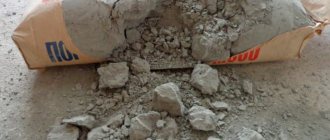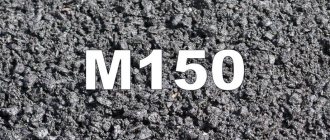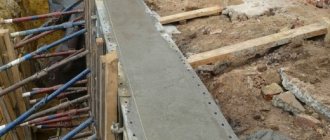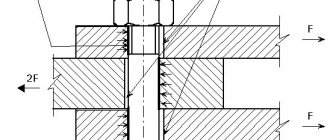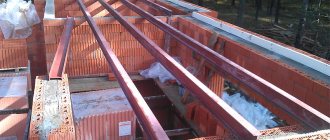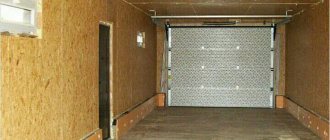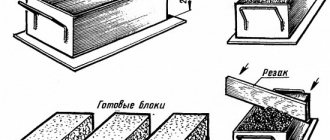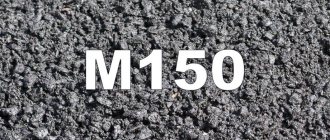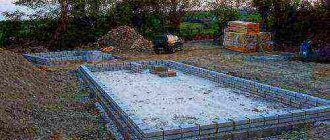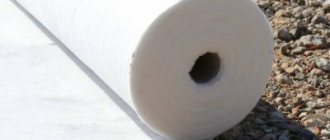Any material for construction requires its own fastening. For example, an anchor is used for foam concrete. Foam concrete surfaces can have several different fasteners that easily fit into the material and create a reliable fastening for each structure. The main purpose of fastening is to withstand any load. The anchor can be made from either plastic or metal. This fastener is a universal fastening device capable of not only securing parts, but also holding entire structures. Foam concrete is endowed with great advantages, but along with the positive qualities there are also negative aspects that can cause complications in construction work. The porosity of the material does not accept nails or fastening dowels. Therefore, it is necessary to have such fastening devices that would not harm or destroy the foam concrete monolith. There are a sufficient number of fasteners for this material; the main thing is to determine the correct material suitable for the job.
Types of fastening anchors for foam concrete
Unlike conventional dowels, an anchor bolt is a full-fledged fastening element that does not require the use of additional components during installation.
In practice, various variants of products have been used, differing in the mechanism of fixation in foam concrete walls. However, they differ significantly in two ways:
- mechanical - wedging and securing the anchor in foam concrete;
- chemical - strong adhesive connection.
Ultimately, all methods act in the same direction - they eliminate the point load on the porous surface of the foam block, distributing it over the entire depth and diameter of the fastening structure.
The advantage of anchors is their load-bearing capacity. Thanks to them, complex facade systems, heavy furniture cabinets, and household appliances are attached to foam concrete. Standard dowel-nails are not suitable for such conditions; they are torn out of the porous material.
Plastic for foam concrete
A plastic anchor is used to fix wood or thin-sheet panels. Plastic fasteners are widely used during the fastening of drywall, brickwork and foam concrete. For the production of such fastening anchors, a material is selected that is not afraid of humidity and other climatic conditions. Foam concrete fasteners made of plastic are used for fastening plumbing fixtures and connecting materials to them. Dowels made of plastic have external threads applied to cut into the foam concrete surface and create an internal stop in it. Installation of fasteners is quick and easy, without causing damage to the plaster.
Features with pros and cons
When choosing, pay attention to the following operational and technical characteristics of anchors for foam blocks, on which the scope of application depends. The following indicators should be taken into account:
- Fastener length. Inexperienced craftsmen sometimes make a mistake due to which the opposite side of the blocks falls out during installation. Pay attention to this parameter when attaching structures to thin foam concrete.
- Diameter (in mm), on which the load-bearing capacity depends. In most cases, fasteners from 8 to 14 mm are used, but for heavier structures, anchors with a larger cross-section are required.
- The material from which the spacer is made. As a rule, it is metal or plastic. Metal products have greater strength and load-bearing capacity.
- The shape of the fastening screw head - it is possible to choose a hidden version or for a bolt, nut, or hook. The latter, for example, is suitable for hanging furniture cabinets and boilers.
In addition, you can select drive-in and screw-in anchors for foam concrete. Hammering an anchor into a foam block is certainly much easier and faster. But twisting creates better fixation, which is especially important under high loads.
Metal elements
This fastener is widely used; its cost is not much higher than that of plastic products, and its load-bearing capacity reaches 200-400 kg even with a small diameter. Most are characterized by the following design:
- movable threaded rod with a nut or wrench head (screwdriver);
- a metal case that corresponds to the declared diameter, with cuts along the entire length or only in the extreme part.
Metal anchors on foam blocks work as follows:
- When the rod is twisted, the support clamp located at the very beginning begins to move.
- Under the influence of the latch, the diameter of which is larger than that of the metal body, the petals begin to move apart, creating additional pressure on the walls of the mounting hole.
The increasing friction force between the anchor metal and the foam block ensures reliable fixation. The opening petals of the anchor body, which cut into the wall material, also provide additional strength. Pulling it out, even with the use of special tools, will be problematic.
Plastic fasteners
Novice builders classify anchors as fasteners consisting of a plastic dowel and powerful load-bearing bolts or self-tapping screws. From a technical point of view, this definition is not considered correct, but it has taken root and is often used.
For wall materials with a porous structure, it is worth using plastic fasteners with external threads. Thanks to its large pitch, they can be screwed into thermal insulating foam blocks without difficulty using a screwdriver or a specialized corded power tool.
For foam concrete I recommend plastic elements made of nylon. They have greater fracture strength compared to parts made from other types of polymers. It is better to avoid driven fasteners; such products are more suitable for standard concrete. In foam blocks they cannot provide the required reliability of fixation of even light façade structures.
Adhesive anchor
If you need to fasten critical structures, heavy furniture cabinets, and household appliances, pay attention to chemical anchors. This technology does not involve any mechanical methods of fixation due to the expansion of the fastener body - the metal supporting rod is fixed in the foam block using glue.
The work flow in this case looks like this:
- Drill a hole in the wall. The diameter is selected in accordance with the cross-section of the stud.
- We clean it with a special brush and blow it with compressed air. (If dust is left, the adhesive will not adhere firmly and the joint will weaken significantly).
- Fill the prepared hole 3/4 full with the injection solution and screw in the supporting pin.
You can use the anchor installed in the foam block only after the glue has completely polymerized! This may take from 30 minutes to 48 hours depending on the composition (see what is written on the package).
Mixtures for injecting chemical anchors for foam blocks can be epoxy, polyester, epoxy acrylate, etc. All of them work well both on the inside of walls and on the facade.
But perhaps the best in terms of quality and reliability is the chemical anchor for foam blocks based on epoxy. They provide reliability in any operating conditions. Withstands exposure to negative temperatures, humidity, and precipitation.
Foundation bolt
It can also be said to be an anchor for a foam block. Although it cannot be classified as specialized, necessary only for foam concrete walls.
Of course, foundations are not made from materials with such porosity. When building a house from a foam block, bolts of this category will be needed to tie the mauerlat to the upper reinforced belt and arrange a grillage between the supports of a pillar or pile foundation.
Fasteners of this class are steel threaded rods that are connected to the reinforcement frame of a monolithic structure and filled with concrete. Then other necessary elements of walls, frames, and roofs are attached to them.
This also includes powerful wood grouse (screw bolts), which are installed in concrete using plastic dowels. This fastening method simplifies installation and eliminates the need for pre-installation of studs and bolts, which can be knocked out of place when pouring concrete.
The technology is actively used in private and industrial construction, gradually replacing the use of embedded parts.
Anchor bolt for foundations
Heavy structures are fixed to foam concrete using a foundation bolt. It is made in the form of a rod, with a thread and a fastening cap. Its dimensions vary, it all depends on the structures that will be installed, and this determines the cost of the foundation bolt.
Working with fasteners
Working with fasteners for foam concrete is a pleasure. The technology of work consists of screwing the parts and then opening them into the hole in the material. There are no complex operations in this work. You just need to use a drill to drill a hole and remove the waste generated during work. Insert the selected element for fastening into this hole and screw it to a certain depth.
Which fastener is better
All presented options cannot be compared with each other and look for which one is better. It will be like trying to choose between a screw and a bolt, a rivet and glue. Each type of fastener is designed for use in individual conditions and is calculated according to the permissible load.
Therefore, do not try to understand which one is better based on only one parameter, price, for example. Analyze the problems that require solutions, estimate the weight of the structures.
It is worth listening to the manufacturers of facade systems or the same furniture that they are going to attach to walls made of foam blocks. They know better the features and weight of their structures. And, more likely, they will recommend the right anchor for foam concrete.
Why does foam concrete need special fasteners?
The main distinctive features of foam blocks: low weight, low density, high level of hygroscopicity, porous structure. For the most part, properties act as advantages during the construction and operation of buildings, but not at the moment of attaching some objects to the walls.
The structure of foam concrete is porous, the adhesion to materials is not very good, so the blocks cannot always cope with the loads, and therefore special dowels are provided for them.
Properly selected fasteners for foam blocks will not only secure equipment or furniture with high quality, but will also strengthen the working structure and significantly increase the percentage of permissible loads.
There are also chemical anchors for foam blocks, which are created specifically for working in cellular concrete and provide maximum quality of fastening. In this case, the main task of the dowel is to create internal support in the block during the expansion process inside the aerated concrete and preserve the fragile material from destruction.
Dowels can be of different diameters and lengths, made of metal or plastic, and are supplied in packs of 50-1000 pieces. According to the scope of application, dowels for foam concrete are intended for external/internal work, according to the installation method - driven, screwed and others (chemical anchors are distinguished separately).
Choosing an anchor for a specific case
In general terms, we can describe the main types of anchors used in the construction of houses made of foam blocks, depending on the type of structures being attached:
- for mounting strips of window and door blocks, products with a countersunk head are suitable;
- fastening the frame under drywall can be done using plastic elements suitable for the permissible load;
- installation of the supporting system of suspended facades is done using metal anchors;
- The chemical anchor is versatile, so it can be used for any purpose, but the polymerization time of the glue should be taken into account.
Remember also that cheap dowel-nails designed for dense wall materials and floors are not suitable when working with foam concrete and other cellular blocks.
Saving on fasteners will lead to a decrease in the service life of the facade and will cause breakage of furniture cabinets and heavy household appliances.
Therefore, when buying anchors for foam blocks, follow the right rule: do not save! Better with a margin of safety.

